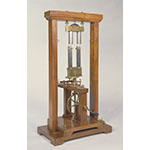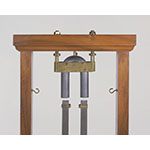One of the earliest magneto-electric generators for producing electric current. A mahogany frame supports a horseshoe electromagnet suspended from the upper cross-piece (today only the electromagnet's iron core survives; the coils are missing). The rest of the machine is mounted on a separate base, secured to the base of the frame by means of large butterfly screws. A horseshoe permanent magnet is rotated by means of a geared handle under the poles of the suspended electromagnet. This produces an induced alternating current that is rectified by Ampère's rocking commutator, actuated by a cam on the axis of the armature. Hippolyte Pixii made instruments for Jean-François-Dominique Arago and André-Marie Ampère and, with Ampère's help, developed this machine in 1832. Although basically a laboratory apparatus, this generator was a landmark in the transformation of mechanical energy into electricity.











